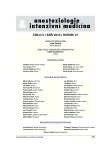Effect of early use of high frequency oscillation in children with respiratory failure
Authors:
Koudelková Ludmila; Košut Peter; Žurek Jiří; Marek Lukáš; Fedora Michal
Authors‘ workplace:
Klinika dětské anesteziologie a resuscitace, Pracoviště dětské medicíny, Fakultní nemocnice Brno
Published in:
Anest. intenziv. Med., 21, 2010, č. 5, s. 245-250
Category:
Intensive Care Medicine - Original Paper
Overview
Objective:
To demonstrate the effect of high frequency oscillation (HFOV) on gas exchange in children with ARDS. To compare the groups with early and late application of HFOV for different variables.
Design:
Retrospective analysis of the group of patients hospitalized from January 1994 to December 2006.
Setting:
Department of Paediatric Anaesthesiology and Resuscitation, University Hospital.
Materials and methods:
Fifty patients with severe hypoxaemic respiratory failure were included. The patients were included in the „early“ group (n = 30, 60%) if commenced on HFOV within 24 hours of initiating mechanical ventilation, or in the „late“ group if HFOV was commenced later than that. We studied the demographic data, PRISM score, primary diagnosis, time of ventilation, variables of acid-base balance, indexed variables (AaDO2, OI, PaO2/FiO2) and the oscilator settings (Paw, FiO2). Evaluation of the group mortality was performed.
Results:
In both the groups pH and PaCO2 values improved achieving normal values. The early commencement group showed significant improvement in the values of AaDO2, PaO2/FiO2 and OI. The late commencement group did not show significant difference compared with baseline. Significant differences in the values of Paw were observed between the groups and a necessity for higher Paw setting in the late commencement group was evident. It was possible to decrease FiO2 faster in the early commencement group compared with the late commencement group. The mortality was 53 % in the early commencement group compared with 75 % in the late commencement group.
Conclusion:
Early switch to HFOV had a positive influence on ventilation and oxygenation. Significant beneficial difference between the groups was observed mainly in AaDO2, PaO2/FiO2 and OI. The observed difference in mortality was not statistically significant but it could point to the ideal timing of commencing the patient on HFOV.
Keywords:
respiratory failure – ARDS – children – high frequency oscillatory ventilation
Sources
1. Roubík, K. Vysokofrekvenční oscilační ventilace. Medical Tribune, 2007, III, 4, p. B5.
2. Null, D.,Perlmann, N. High Frequency Oscillatory Ventilation: Disease Specific Clinical Management. Strategie [online], c2008 [cit. 2008-06-26]. Dostupný na www: http:www.sensormedics.com.
3. Dostál, P. et al. Základy umělé plicní ventilace. Maxdorf-Jesenius: Praha, 2005.
4. Slutsky, A. S. et al. ACCP Consensus Conference: mechanical ventilation. Intensive Care Med., 1994, 20, p. 64–79.
5. Fedora, M. Vliv terapeutického protokolu na mortalitu syndromu akutní respirační tísně v dětském věku. Habilitační práce, LF MU Brno 2005.
6. Ritacca F. V., Stewart, T. E. Clinical review: High-frequency oscillatory ventilation in adults-a review of the literature and practical applications. Crit. Care, 2003, 7, p. 385–390.
7. Fort, P., Farmer, C. , Westerman, J. et al. High-frequency oscillatory ventilation for adult respiratory distress syndrome:a pilot study. Crit. Care Med., 1997, 25, p. 937–947.
8. Mehta, S., Lapinsky, S. E. , Hallett, D. C. et al. Prospective trial of high-frequency oscillation in adults with acute respiratory distress syndrome. Crit. Care Med., 2001, 29, p. 1360–1369.
9. Derdak, S., Mehta, S., Stewart, T. E. et al. High-Frequency Oscillatory Ventilation for Acute Respiratory Distress Syndrome in Adults. Am. J. Respir. Crit. Care Med., 2002, 166, p. 801–808.
10. Ben Jaballah, N. et al. High-frequency oscillatory ventilation in paediatric patiens with acute respiratory distress syndrome-early rescue use. Eur. J. Pediatr., 2005, 164, 1, p. 17–21.
Labels
Anaesthesiology, Resuscitation and Inten Intensive Care MedicineArticle was published in
Anaesthesiology and Intensive Care Medicine

2010 Issue 5
Most read in this issue
- Recombinant activated factor VII (rFVIIa) in the treatment of life threatening post-partum haemorrhage – data from the UniSeven clinical registry in the Czech Republic
- Application of recombinant factor VIIa for refractory bleeding in patients with liver trauma – case reports
- Effect of early use of high frequency oscillation in children with respiratory failure
- Spontaneous delivery during ECMO for H1N1 pneumonia-related ARDS – case report
